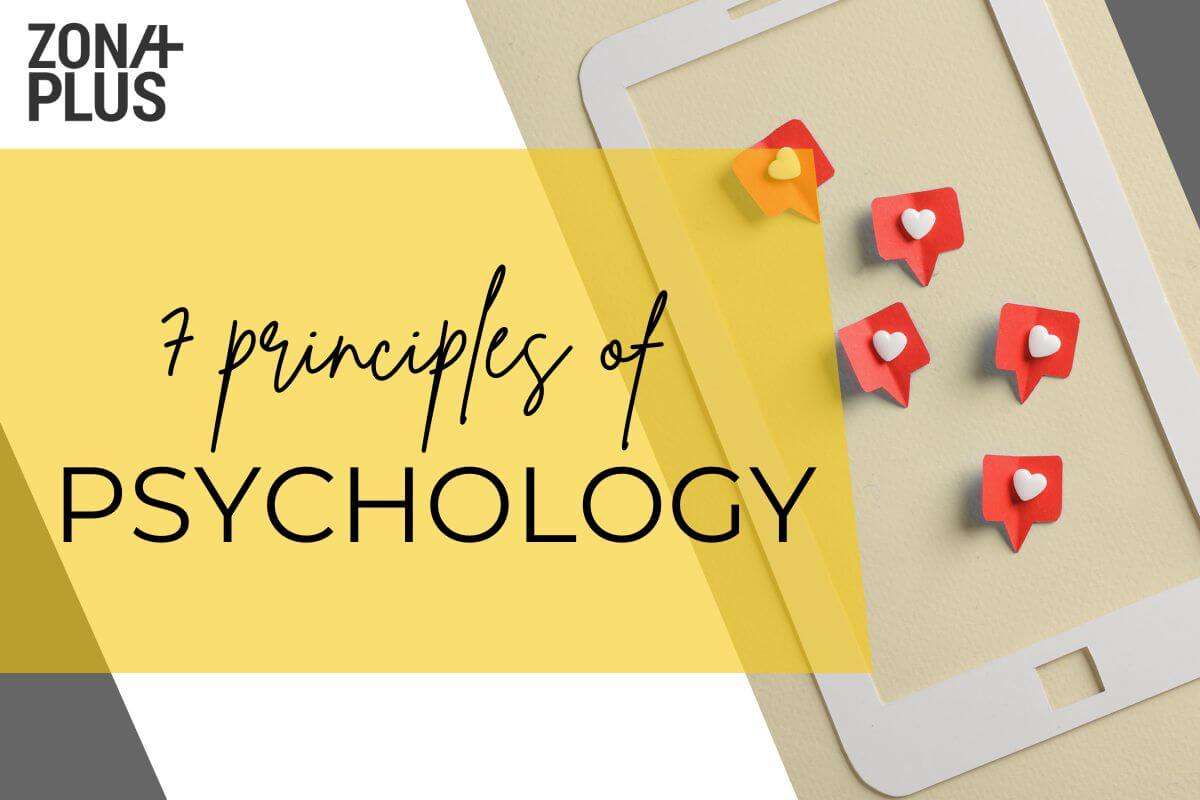If you think about it - what is marketing but pure psychology?
What is used to make someone like something so much that they need it, want it, and then go and buy it? Psychology.
Psychology and social media marketing have a fascinating connection between human awareness and digital interactions.
Digital marketing experts and content creators simplify complex human behaviour by demystifying people's needs and wishes.
They use psychology principles to elevate the brand-customer relationship and set the foundation for sustainable growth and loyalty.
Do you want to foster a deeper connection with your online community? Learn more about the seven principles of psychology.

1. The principle of reciprocity
At its core, the principle of reciprocity is a fundamental human instinct that influences our behaviour in society, including our online interactions.
It's the psychological inclination to return a favour or respond in kind to the actions of others.
In social media, this principle can foster an engaged community by strategically offering value to your audience. It encourages them to reciprocate through engagement, loyalty, and advocacy.
The reciprocity principle on social media starts with understanding your audience's needs, desires, and challenges.
Align your content to create insightful articles, helpful tutorials or engaging stories that enrich your audience's social media experience.
When followers perceive the value in your content, they are more inclined to engage with your brand, share your content, and support your business initiatives.
Practical tips for creating content that offers real benefits to followers:
- Listen: Actively listen to your audience. Use social media analytics and direct feedback to understand what content resonates most and tailor your content to match.
- Educate: Share your expertise freely. Educational content that helps your audience solve problems or learn something new is incredibly valuable. It positions you as a trusted resource, encouraging followers to return the favour with their loyalty and engagement.
- Engage: Create interactive content such as polls, quizzes, and challenges to engage your followers actively. These interactive elements invite participation and sharing, naturally encouraging followers to contribute to the community.
- Appreciate: Show gratitude for your audience's engagement. Whether featuring user-generated content or responding to comments, acknowledging your audience's contributions fosters a positive cycle of reciprocity.
- Offer exclusivity: Reward your followers with exclusive content, early access to products or services, and special discounts. This adds value and makes your followers feel esteemed and valued, motivating them to support and promote your brand.

2. The power of social proof
Social proof stands as a pillar of consumer trust and credibility online. It operates on the premise that people are influenced by the actions and approvals of others.
By incorporating testimonials, reviews, and user-generated content (UGC) into your social media strategy, you can harness the persuasive power of social proof to elevate your reputation and foster trust among your audience.
What strategies to use to showcase social proof effectively on your platforms:
- Share testimonials: Highlight positive customer experiences to sow your product's value and amplify customer voices, making your brand feel more relatable and trustworthy.
- Leverage reviews: Integrate product or service reviews into your social media feeds. Displaying them, especially with detailed specific benefits or how they overcome issues, can significantly influence potential customers' perceptions and buying decisions.
- Promote user-generated content: Encourage followers to share their experiences with your brand or products through a branded hashtag. Sharing this UGC provides authentic proof of customer satisfaction and enhances engagement.
- Highlight milestones and achievements: Sharing milestones, such as the number of followers or customers served, demonstrates your brand's success and reliability to new and existing followers.
- Partner with others: Collaborations with influencers or brand advocates can lend their credibility to your products. Their endorsements are a potent form of social proof, leveraging their trust with their followers to boost your brand's image.
3. The commitment and consistency concept
Psychological concept of commitment and consistency suggests that once an individual commits to something, they are more likely to engage in compatible behaviours.
This translates into maintaining a harmonious and consistent message, tone, and aesthetic across all channels for brands.
Such coherence strengthens brand recognition and cultivates trust and reliability in the eyes of the audience.
Strategies for implementing consistent messaging and branding:
- Comprehensive brand guide: Establish a detailed brand guide encompassing your brand's voice, tone, colours, and visual elements. This ensures that all content, regardless of the platform it's on, reflects your brand's core identity.
- Craft engaging narratives: Create compelling stories that resonate with your audience's values and interests. This reinforces brand ethos and fosters a deeper connection with your community.
- Utilize multi-channel strategies: Tailor your messaging to fit each platform's unique context and audience while keeping a cohesive brand story. This ensures that your brand is recognizable and relatable, whether it's met on Instagram, Facebook, or LinkedIn.
- Engage consistently: Regularly interact with your audience through comments, messages, and community posts. This demonstrates commitment to your community and encourages ongoing interaction, building a loyal (and active) online community.
- Monitor and adapt: Monitor your brand's performance across platforms. Use insights and feedback to refine your approach so that your messaging is consistent yet adaptable to changing audience needs and preferences.

4. The scarcity effect
The scarcity effect is a potent psychological lever, compelling users to act swiftly under the fear of missing out (FOMO).
This principle, grounded in the human instinct to value what's rare, can amplify engagement and conversions.
If you craft limited-time offers and exclusive content, you can create a sense of urgency that encourages immediate action without building frustration or scepticism among your audience.
Strategies for effective use of scarcity:
- Craft genuine limited-time offers: Create compelling, time-sensitive, but realistic offers. Overuse or false scarcity can erode trust and devalue your brand's integrity.
- Promote exclusive access: Offer your most loyal customers or subscribers exclusive access to products, services, or content before a wider release.
- Highlight limited availability: Clearly communicate when an item or offer is in short supply. This can drive action by highlighting the exclusivity and limited nature of the opportunity.
- Balance urgency with transparency: While creating urgency is effective, being transparent about availability preserves trust with your audience.
- Incorporate social proof: Combine scarcity with social proof, such as testimonials, to validate the demand and value of your offering, making the opportunity seem even more exclusive and desirable.
- Monitor and measure: Keep a close eye on how your scarcity campaigns perform. Be ready to adjust based on feedback and results. This way, you maintain a positive brand perception while perfecting engagement and conversion.
- Provide genuine value: Even as you employ scarcity, ensure that every content or offer delivers real value. This way, customers feel their quick response was worthwhile, deepening their connection with your brand.

5. The authority principle
Almost every industry is teeming with competition, and establishing your brand as an authoritative voice in your niche is essential.
The authority principle is the psychological inclination of individuals to trust and follow the guidance of experts.
For brands, this means using your unique insights, experience, and knowledge to not just participate in the conversation but to lead it.
This kind of leadership fosters trust and loyalty among your audience as a beginning for sustained engagement and conversion.
Strategies to showcase expertise and knowledge:
- Create high-quality, informative content: Dedicate resources to producing well-researched and interesting blog posts, white papers, and videos that address the needs and questions of your audience. Quality content that educates and informs shows your expertise and adds real value to your audience's lives.
- Host webinars and workshops: Use these platforms to share your knowledge directly with your audience. Interactive sessions position you as a thought leader and allow you to engage with your community in real-time.
- Use case studies and success stories: Demonstrating how your products or services have solved real problems reinforces your authority and provides tangible proof of your expertise.
- Engage in public speaking and industry panels: Participating in industry events as a speaker or panellist elevates your visibility and sets up your brand as a go-to source for insights and solutions.
- Regularly update your content: Keeping your content current with the latest research, trends, and innovations signals that your brand is a leader, not a follower, in your field.
- Optimise for SEO: Ensure that your content is easily discoverable online. Use SEO best practices to increase your visibility in search engine results, making it easier for your audience to find (and trust) you.
- Present customer testimonials and reviews: Positive feedback from satisfied customers is a powerful endorsement of your authority and reliability.

6. The liking principle
Brands that stand out are those that resonate personally with their audience.
The liking principle uses the power of relatability and personal connection to foster brand loyalty.
Its root is in the simple yet profound psychological truth that people are more inclined to support and purchase from brands they like and feel connected to.
This principle isn't just about surface-level appeal; it's about forging genuine bonds by humanizing your brand and nurturing meaningful interactions.
Strategies to enhance relatability and connection:
- Show your brand's personality: Let your unique voice and personality be heard and seen in every post, story, and interaction. Whether your tone is humorous, inspirational, or educational, consistency in your brand's personality fosters familiarity among your audience.
- Engage authentically with your community: Don't just respond to comments and messages; engage in honest conversations. Ask questions, seek opinions, and participate in discussions. Authentic engagement shows your audience that real people are behind the brand, deepening their connection to you.
- Share behind-the-scenes content: Give your followers a glimpse into your brand's everyday life. Behind-the-scenes content, whether it's the making of a product, team introductions, or office shenanigans, adds a layer of transparency and trustworthiness.
- Tell stories: People love stories. Share what you can about your brand's journey, challenges, and successes. Stories make your brand more relatable and more memorable.
- Support causes and values: Aligning with causes or values that resonate with your audience shows that your brand stands for something beyond profit. This shared sense of purpose can enhance followers' connection with your brand.
7. The principle of unity
The principle of unity is paramount for brands looking to grow and thrive.
This principle supports creating a collective sense of belonging. In this community, followers are active participants who share a common bond.
It's about transforming your brand's social media presence into a place where interactions are meaningful, and followers feel a part of something greater.
Strategies to cultivate a sense of belonging and community:
- Create shared experiences: Organise events to encourage participation and interaction among your followers. Shared experiences can serve as the foundation for community building, where people can connect with the brand and each other on a personal level.
- Highlight community stories: Share stories, achievements, and testimonials from within your community. Recognizing individuals makes them feel valued and shows potential followers the tangible benefits of joining your community.
- Engage in meaningful conversations: Go beyond automated responses and engage in genuine dialogues with your followers. Ask for their opinions, respond thoughtfully to their comments, and show that you value their input.
- Collaborate with your community: Look for opportunities to support your community members, whether through collaborations, featuring their content, or providing platforms for their voices to be heard.
- Be consistent in your values and messaging: Ensure that your brand values are clear and reflected in every piece of content you share. A consistent message helps unite people under a common cause or belief system, enhancing the sense of community.
- Create exclusive spaces: Create exclusive groups or forums where your most engaged followers can connect, share ideas, and have direct access to your brand. These spaces can offer a more intimate setting for community engagement and growth.

Intertwining psychology and strategy for social media mastery
Effective social media presence has to have some elements of psychological principles.
We've explored human behaviour—reciprocity, social proof, commitment and consistency, scarcity, authority, liking, and unity—each a powerful motivator in crafting a brand that resonates deeply with its audience.
These are not just tactics; they help us understand the human psyche and provide a blueprint for meaningful engagement and sustained loyalty.
As we stand between psychology and digital marketing, it's clear – you have to learn to go above traditional approaches and develop a holistic strategy focused on real people.
However, integrating psychological principles demands a specific blend of creativity, empathy, and even strategic foresight.
You'll have to see beyond what the algorithm shows and reach into the very essence of human connection.
If you want to build a community that thrives on genuine interactions, your social media strategy must go beyond mere posts—every post, story, and reel need to communicate (with every meaning of that word).
To use the power of psychology in the best (and correct way), you must not just be present on social media and publish randomly – you must foster a space where every follower feels seen, heard, and valued.
This is the future of social media marketing — an environment rich with possibility, driven by genuine human connection.
To make the most of your online presence, use these principles, and if you need help, contact us; we are here for you.






